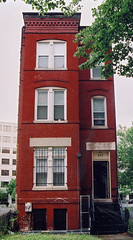Understanding preservation protections: federal; state; local
There are many impressive preservation advocacy groups around the country including the Landmark Society of Western New York, which among other activities publishes the great guide, Rehab Rochester, which they also make available freely online.
The Rochester Democrat and Chronicle has a piece about historic preservation, "Suburban Spotlight: 'Historic' label isn't automatic protection," about their work. The article starts off:
A widely held misconception is that designation on the federal or state registries of historic places is equal to an impenetrable fortress guarding local historic landmarks. But as the residents of Fairport recently found out, the ramparts protecting historic structures such as the 130-year-old First Baptist Church of Fairport are local historic preservation laws.
Historic landmark designation brings prestige and opens access to preservation grants, but it does not protect a building from alteration or demolition.
Cynthia Howk, who has worked for the Landmark Society of Western New York for 30 years, said most people do not understand what historic preservation is and what it means to have a building or property listed on the national or state registry.
DC is simpler than most places because we are a city, county, and state rolled up into one. Federal laws only protect historic resources against federal undertakings. And this process isn't perfect either. In DC, the National Capital Planning Commission is the agency responsible for review of such matters. Nationally, the Advisory Council on Historic Preservation is the lead agency.
Another advantage is that commercial properties in a district listed on the National Register of Historic Places are eligible for renovation tax credits of up to 20%, as well as for conservation easements. While there have been, sadly, many instances of the abuse of the tax credit implications of conservation easements (see this article from the Post, "Tax Break Turns Into Big Business"), for the most part, proper and judicious use of easements have yielded tremendous benefits for community improvement through historic preservation.
But if it's an undertaking by a state or local government agency or an individual property owner, listing on the National Register means nothing. That's why you need strong local laws.
DC's are pretty good. Preservation organizations can nominate buildings for protection, without owner consent. And it's quite difficult to demolish buildings in historic districts. But of course, the laws are subject to interpretation and political pressure. But for the most part, under the Williams Administration, things have been pretty good. Although developers pay "preservation" consultants and land use lawyers good money to figure out how to get around the law.
Here's one: tearing the facades off buildings to preclude the filing of nominations. I have my suspicions on which DC land use lawyer suggested this strategem, but fears of being sued for libel prevent me from writing or speaking much about this.

 439 Massachusetts Avenue NW, Before and After. (And now gone.) Photos by Peter Sefton.
439 Massachusetts Avenue NW, Before and After. (And now gone.) Photos by Peter Sefton.My concern is protection for resources equally historic but not designated. Bobbi Krengel, a member of the ANC6C Planning and Zoning Committee, testifying before the Mayor's Hearing on the NoMa Plan last week, called this the difference between "small h historic and big H historic," referring to eligible vs. designated buildings, equally historic, but one protected under DC law and the other unprotected.
Undesignated buildings have few protections. A nomination can be filed to stave off demolition, but it's only for 90 days. (I was surprised to learn recently that the same provision back in the 1970s allowed for a 180 day period). And if the hearing determines that the building isn't "worthy" (the standards of determination are higher for individual buildings--landmarks--than for buildings that contribute to the overall character of a historic "district") then the building comes down...
I have written about this before. We had managed to get demolition review provisions for "small h" buildings into the draft legislation, but the provisions were stripped out before the bill was passed. And the Building Industry Association trumpeted their success at accomplishing this in their June newsletter...
Anyway, some states have complementary tax credit programs that supplement the federal program. Maryland has a good program in this area, but tinkering with the program because certain quarters felt that Baltimore overbenefited means that some of the yearly tax credit authorization isn't used.
DC recently enacted a tax credit for homeowners of designated-contributing buildings in particular historic neighborhoods, but I must admit I don't follow that particular program too closely.
The National Trust for Historic Preservation is lobbying Congress to provide a tax credit program for homeowners of designated properties. You can imagine with the Republicans in the House, in particular the anti-preservation Congressman Richard Pombo, chair of the House Committee on Resources, means this isn't going anywhere anytime soon.
Index Keywords: historic-preservation



0 Comments:
Post a Comment
<< Home